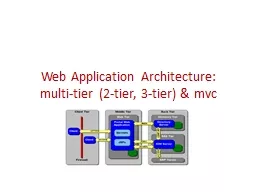

multitier 2tier 3tier amp mvc Data Independence in Relational Databases Ntier Architectures Design Patterns The MVC Design Pattern Overview Data Independence in Relational Databases ID: 423082
Download Presentation The PPT/PDF document "Web Application Architecture:" is the property of its rightful owner. Permission is granted to download and print the materials on this web site for personal, non-commercial use only, and to display it on your personal computer provided you do not modify the materials and that you retain all copyright notices contained in the materials. By downloading content from our website, you accept the terms of this agreement.
Slide1
Web Application Architecture:multi-tier (2-tier, 3-tier) & mvcSlide2
Data Independence in Relational DatabasesN-tier ArchitecturesDesign Patterns
The MVC Design Pattern
OverviewSlide3
Data Independence in Relational DatabasesSlide4
Database Architecture With ViewsSlide5
Logical and Physical IndependenceSlide6
Logical Independence: The ability to change the logical schema without changing the external schema or application programs
Can add new fields, new tables without changing views
Can change structure of tables without changing view
Physical Independence
: The ability to change the physical schema without changing the logical schema
Storage space can change
Type of some data can change for reasons of optimization
LESSON:
Keep the VIEW (what the user sees ) independent of the MODEL (domain knowledge)
Data IndependenceSlide7
N-tier architecturesSlide8
N-tier architectures have the same componentsPresentationBusiness/Logic
Data
N-tier architectures try to separate the components
into different tiers/layers
Tier: physical separation
Layer: logical separation
Significance of “Tiers”Slide9
Significance of “Tiers”
Database runs on Server
Separated from client
Easy to switch to a different database
Presentation and logic layers still tightly connected
Heavy load on server
Potential congestion on network
Presentation still tied to business logicSlide10
1-Tier Architecture
All 3 layers are on the same machine
All code and processing kept on a single machine
Presentation, Logic, Data layers are tightly connected
Scalability: Single processor means hard to increase volume of processing
Portability: Moving to a new machine may mean rewriting everything
Maintenance: Changing one layer requires changing other layersSlide11
2-Tier Architecture
Database runs on Server
Separated from client
Easy to switch to a different database
Presentation and logic layers still tightly connected (coupled)
Heavy load on server
Potential congestion on network
Presentation still tied to business logicSlide12
3
-Tier Architecture
Each layer can potentially run on a different machine
Presentation, logic, data layers disconnectedSlide13
A Typical 3-tier Architecture
Architecture Principles
Client-server architecture
Each tier (Presentation, Logic, Data) should be independent and should not expose dependencies related to the implementation
Unconnected tiers should not communicate
Change in platform affects only the layer running on that particular platformSlide14
A Typical 3-tier Architecture
Presentation Layer
Provides user interface
Handles the interaction with the user
Sometimes called the GUI or client view or front-end
Should not contain business logic or data access codeSlide15
A Typical 3-tier Architecture
Logic Layer
The set of rules for processing information
Can accommodate many users
Sometimes called middleware/ back-end
Should not contain presentation or data access codeSlide16
A Typical 3-tier Architecture
Data Layer
The physical storage layer for data persistence
Manages access to DB or file system
Sometimes called back-end
Should not contain presentation or business logic codeSlide17
The 3-Tier Architecture for Web AppsPresentation Layer
Static or dynamically generated content rendered by the
browser (front-end)
Logic Layer
A dynamic content processing and generation level
application server, e.g., Java EE, ASP.NET, PHP, ColdFusion
platform (middleware)
Data Layer
A database, comprising both data sets and the database management system or RDBMS software that manages and provides access to the data (back-end)Slide18
3-Tier Architecture - AdvantagesIndependence of Layers
Easier to maintain
Components are reusable
Faster development (division of work)
Web designer does presentation
Software engineer does logic
DB admin does data model